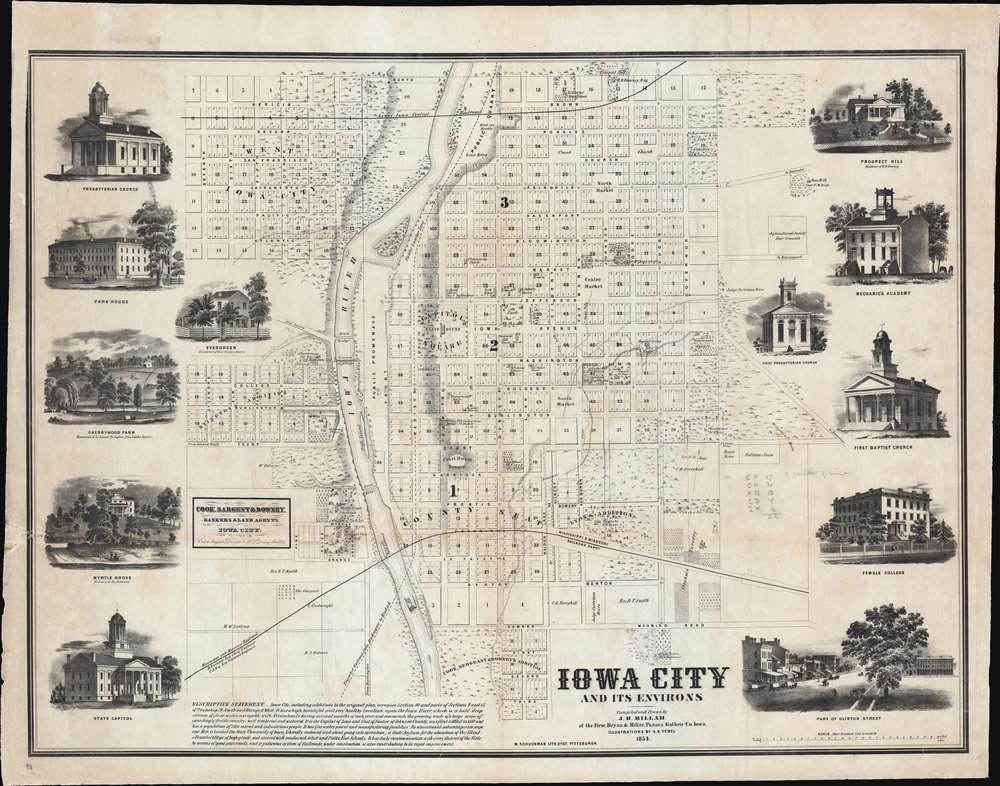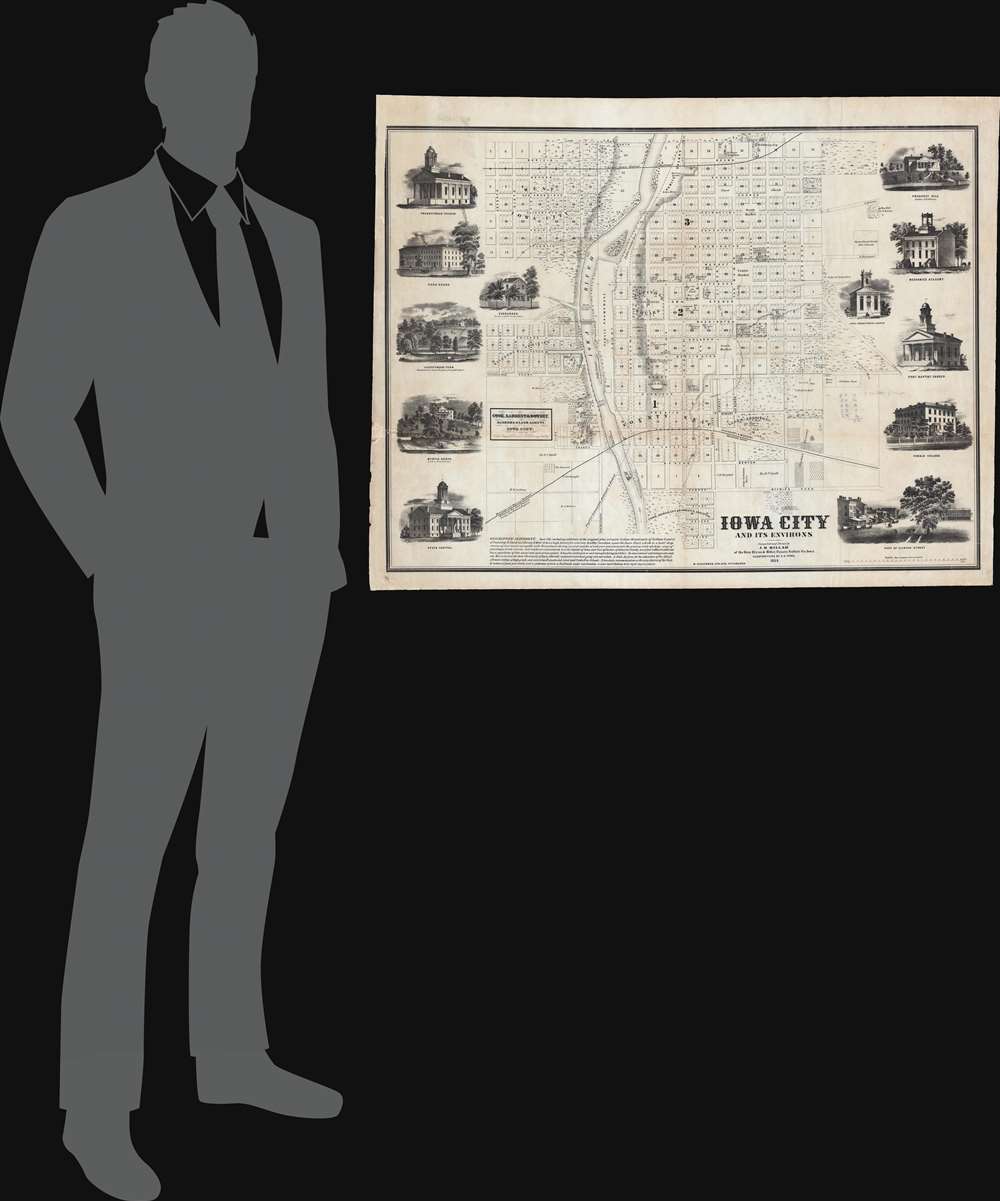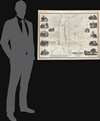Digital Image: 1854 Millar Promotional Map of Iowa City, Iowa
IowaCity-millar-1854_d
Title
1854 (dated) 28 x 35.5 in (71.12 x 90.17 cm) 1 : 4800
Description
FOR THE ORIGINAL ANTIQUE MAP, WITH HISTORICAL ANALYSIS, CLICK HERE.
Digital Map Information
Geographicus maintains an archive of high-resolution rare map scans. We scan our maps at 300 DPI or higher, with newer images being 600 DPI, (either TIFF or JPEG, depending on when the scan was done) which is most cases in suitable for enlargement and printing.
Delivery
Once you purchase our digital scan service, you will receive a download link via email - usually within seconds. Digital orders are delivered as ZIP files, an industry standard file compression protocol that any computer should be able to unpack. Some of our files are very large, and can take some time to download. Most files are saved into your computer's 'Downloads' folder. All delivery is electronic. No physical product is shipped.
Credit and Scope of Use
You can use your digial image any way you want! Our digital images are unrestricted by copyright and can be used, modified, and published freely. The textual description that accompanies the original antique map is not included in the sale of digital images and remains protected by copyright. That said, we put significant care and effort into scanning and editing these maps, and we’d appreciate a credit when possible. Should you wish to credit us, please use the following credit line:
Courtesy of Geographicus Rare Antique Maps (https://www.geographicus.com).
How Large Can I Print?
In general, at 300 DPI, you should at least be able to double the size of the actual image, more so with our 600 DPI images. So, if the original was 10 x 12 inches, you can print at 20 x 24 inches, without quality loss. If your display requirements can accommodate some loss in image quality, you can make it even larger. That being said, no quality of scan will allow you to blow up at 10 x 12 inch map to wall size without significant quality loss. For more information, it is best consult a printer or reprographics specialist.
Refunds
If the high resolution image you ordered is unavailable, we will fully refund your purchase. Otherwise, digital images scans are a service, not a tangible product, and cannot be returned or refunded once the download link is used.
Cartographer S
William Schuchman (1824 - 1864) was a German-American lithographer based in Pittsburgh. Schuchman was born in Hessen, Germany. Both his and his brother George Frederick Schuchman were '48ers' felling the failed Springtime of Nations revolutions in Germany. They immigrated to the United States in 1848, settling in Pittsburg in 1849. He is credited with issuing the first lithograph in Pittsburg, around 1850. Schuchman and his brother set up their lithographing studio in Pittsburgh in 1849. Their first advertisements appeared in the Pittsburg Daily Gazette on October 15, 1849. He was a Mason. Schuchman disappears from all records and presumably died in 1864 - in the Civil War? More by this mapmaker...
George Henry Yewell (January 20, 1830 - September 26, 1923) was an American painter, etcher, and engraver. Yewell was born in Havre de Grace, Maryland. His father died when he was a child and afterward, his family moved west to Cincinnati. There Yewell studied under the famous educator Theodore S. Pavin (1817 - 1901). In 1841, Yewell and his mother relocated to Iowa City, Iowa - then just being built as a new state capital. In 1848, Yewell apprenticed to a local tailor, but by this time had already begun to show proficiency as an artist. He issued a political cartoon about moving the capital to Iowa City that caught the attention of Charles Mason, Chief Justice of the Iowa Supreme Court. Mason and several associates sponsored Yewell to study in New York, where he became a student of painter Thomas Hicks (1823 - 1890). From 1851 to 1853 he studied at the National Academy of Design. He returned to Iowa City in 1853, where he did portraiture and landscape art. He returned to New York in 1856, reenrolling at the National Academy for further studies. With Mason's sponsorship he went to Paris, where he studied until 1861 under French painter Thomas Couture (1815 - 1879). He returned briefly to Iowa city in 1862, but ultimately the small city ould not hold him. He returned to New York, and from there, returned to Europe in 186. He took up residence in Rome, summer in Perugia and Venice, and traveled extensively, even I 1875 to Egypt. He was deeply entrenched in the European art scene. He returned to New York in the 1880s, where he remained for the rest of his life. He worked occasionally for Louis Comfort Tiffany, and spent summers on Lake George. He was elected an Associate of the National Academy of Design in 1862, and made a full member in 1880. His work is in the collections of numerous museums and private collections in Iowa, New York, and elsewhere. Learn More...




